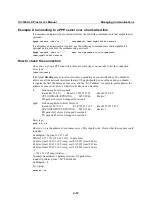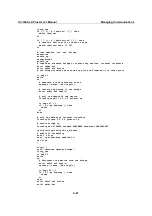
UC-7400-LX Plus User’s Manual
Managing Communications
4-15
7.
Set up DNS
If you are using DNS servers supplied by your ISP, edit the file
/etc/resolv.conf
by adding the following lines of code:
nameserver ip_addr_of_first_dns_server
nameserver ip_addr_of_second_dns_server
For example:
nameserver 168.95.1.1
nameserver 139.175.10.20
8.
Use the following command to create a pppoe connection:
pppd eth0
The eth0 is what is connected to the ADSL modem LAN port. The example above uses LAN1.
To use LAN2, type:
pppd eth1
9.
Type
ifconfig ppp0
to check if the connection is OK or has failed. If the connection is OK,
you will see information about the ppp0 setting for the IP address. Use ping to test the IP.
10.
If you want to disconnect it, use the kill command to kill the pppd process.
NFS (Network File System)
The Network File System (NFS) is used to mount a disk partition on a remote machine, as if it
were on a local hard drive, allowing fast, seamless sharing of files across a network. NFS allows
users to develop applications for the
UC-7400-LX Plus, without worrying about the amount of
disk space that will be available. The UC-7400-LX Plus supports NFS protocol for both client and
server.
NOTE
Click on the following links for more information about NFS:
Setting up the UC-7400-LX Plus as an NFS Server
By default, the UC-7400-LX Plus enables the service
/etc/init.d/nfs-user-server
. The service link
file
S25nfs-user-server
is located in the directory
/rc.d/rc2.d-rc5.d
.
Edit the NFS server configuration file
/etc/exports
to set up the remote host (NTF client) list and
access rights for a specific directory. The file formats are shown below:
#vi /etc/exports
File Format:
directory machine1(option11,option12) machine2(option21,option22)
directory
The directory that will be shared with the NFS Client.
machine1 and machine2
Client machines that will have access to the directory. A machine can be listed by its DNS
address or IP address (e.g., machine.company.com or 192.168.0.8).






























